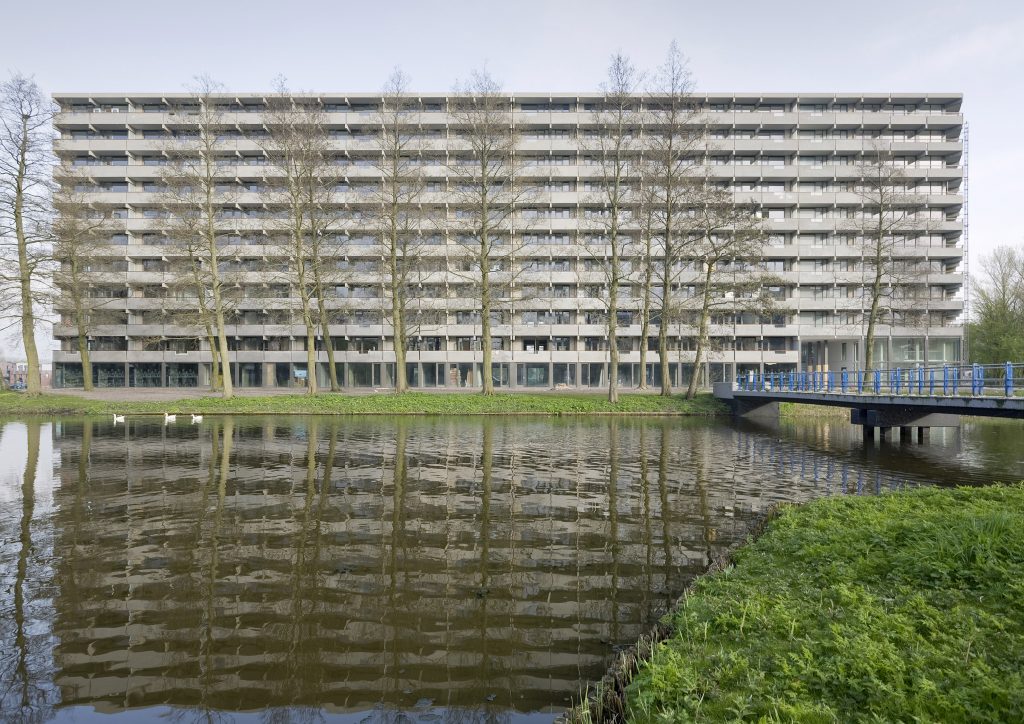
NL Architects, XVW architectuur: deFlat Kleiburg, Amsterdam, NL
© photograph: Marcel van der Burg
What are the best European buildings? For the first time the most prestigious European architecture prize is awarded to two housing developments.
Every two years the exhibition ‘Europe’s Best Buildings’ puts the focus on exceptional building projects in Europe, becoming a crowd-puller in recent years. The exhibition is based on The European Union Prize for Contemporary Architecture. Mies van der Rohe Award, with a total of 80,000 Euro prize money. Having been awarded to predominantly sensational cultural buildings in previous competitions, this time the prize goes to two pioneering projects in the field of housing. The main prizewinning project, De Flat Kleiburg by NL architects and XVW Architectuur, involves the participative renovation and upgrade of a prefab development from the 1960s. One topic that is highly relevant here in Austria, where we are confronted with many major housing developments by postwar modern architects that are ageing and urgently need social, functional and technical renovation. The Emerging Architect Special Mention goes to a social housing complex by the offices of MSA and V+ in Brussels.
Both prizewinning projects provide new reactions to the lifestyle changes of the 21st century. “The shift towards social housing, but with a concentration on converting and extending the existing substance, is a clear sign of a reorientation in architecture towards equitable building and the economic use of resources”, says Angelika Fitz, Director of the Az W. On show in the exhibition are a total of 40 buildings from the sectors of housing, culture, education, industry and infrastructure. They were all selected by a high-calibre jury from 355 projects, from 36 European countries. “The exhibition uses models, videos, original drawings and 1:1 structural elements to clearly convey the high quality of the projects”, explains curator Ivan Blasi of the Mies van der Rohe Foundation. In addition, at the Az W the 18 Austrian nominated projects are on display. The accompanying catalogue presents all of the nominated projects.
Housing Wins
In the main prizewinning project De Flat, the 400 metre long Kleiburg block estate containing 500 homes in the Amsterdam district of Bijlmermeer was given a second life. The De Flat consortium founded for the project saved the late-1960s building from demolition. While NL Architects and XVW Architectuur restored the communal spaces and made a number of essential interventions, the business concept envisaged prospective occupants’ renovating their apartments by themselves. The Emerging Architect Award goes to an apartment building with 5 social homes for low-income families with many children. With this project the team of architects MSA and V + have successfully achieved both an identity for the district as well as spatial generosity with an exemplary apartment building. Resourceful responses to the economic and structural restrictions have created homes with a great deal of freedom of movement and a superb view of the surrounding landscape.
Pioneering European Architecture
Among the other finalists presented extensively in the exhibition are the projects Kannikegården by Lundgaard & Tranberg Architects, which fits uniquely into the ensemble of the medieval main square in Ribe, Denmark; the Rivesaltes Memorial Museum in France by Rudy Ricciotti, which is buried in the earth with calm and determination, the power of the architecture lending expression to the history of Concentration Camp Joffre; Ely Court, another housing development project from London, by Alison Brooks Architects, and the Katyn Museum in Warsaw by BBGK Architekci, Jerzy Kalina and Maksa, which engages impressively with the history and with the location.
The remaining shortlisted projects also represent an impressive cross-section of the development of European architecture. The examples range from cultural buildings, like the extension of the Museo de las Colecciones Reales in Madrid by Mansilla + Tuñón Arquitectos, via educational buildings, like the Inchicore Model School in Dublin by Donaghy + Dimond, infrastructure projects, like the Landmark by Monadnock with a café and visitor centre for the city of Nieuw-Bergan in the Netherlands, to commercial and office buildings, like the Timmerhuis by O.M.A. in Rotterdam.
The Mies van der Rohe Award
The key aim of the Mies van der Rohe Awards is to provide recognition and show appreciation for exceptional achievements in the field of architecture within Europe. Projects are awarded prizes whose innovative character serves as orientation, even as manifestos, for the development of contemporary architecture. Prize money totalling 80,000 EUR (Winner: 60,000 EUR, Emerging Architect Award: 20,000 EUR) is awarded for exceptional achievements in conceptual, technical and structural terms. The Emerging Architect Award is intended to promote the profession itself and as encouragement for architects at the outset of their careers. From 355 nominated projects, from 36 European countries, a total of 40 projects were selected for the exhibition by an international jury — Stephen Bates, Gonçalo Byrne, Peter Cachola Schmal, Pelin Dervis, Dominique Jakob, Juulia Kauste and Malgorzata Omilanowska. The exhibition includes the 5 finalists and the two winning projects from the housing sector.
An accompanying catalogue presents all of the nominated projects, and is available throughout the exhibition.
An exhibition by the Fundació Mies van der Rohe – Barcelona
Exhibition design: Jorge Vidal, Monica Vassallo, Gerardo Pérez de Amézaga
Organised by: Creative Europe, Fundació Mies van der Rohe
Board of Trustees: Ajuntament de Barcelona, Gobierno de España – Ministerio de Fomento, Generalitat de Catalunya, Collegi d’Arquitectes de Catalunya, ETSAB, Fira Barcelona, MOMA, Stiftung Preußischer Kulturbesitz
Sponsors: Fundació Banc Sabadell, simon
Contributors: Knoll, USM, ALMA, Ciments Molins, EPSON, arch daily, world-architects.com
